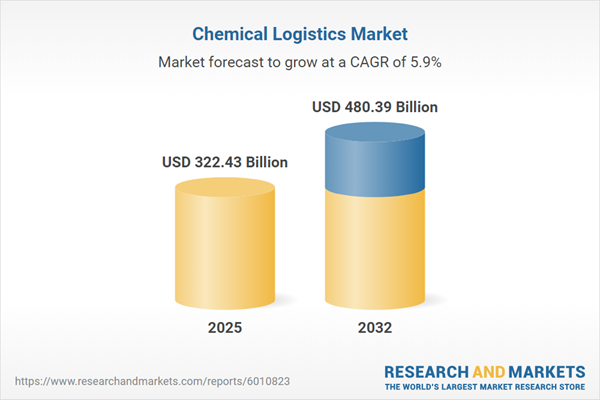Speak directly to the analyst to clarify any post sales queries you may have.
Senior executives in the chemical logistics sector are navigating fast-evolving operational challenges driven by shifting regulatory frameworks, complex supply chains, and accelerating digital innovation. To stay competitive, strategic leaders must focus on agility, compliance, and technology adoption to strengthen resilience and profitability within this dynamic market landscape.
Chemical Logistics Market Snapshot
The chemical logistics market is projected to demonstrate robust value growth, supported by a strong compound annual growth rate through 2024–2032.
Rising demand for transport and supply chain solutions is fueling this expansion. Across the industry, digitalization is accelerating the transition from traditional logistics models, enabling smarter network management and elevating sustainability standards. Investments in infrastructure upgrades, such as compliance-focused technologies and advanced safety measures, are critical for success. Stakeholders are leveraging digital platforms, automating core processes, and staying ahead of regulatory developments, which enables rapid adaptation and robust operational continuity as the market continues to evolve.Chemical Logistics Market: Scope & Segmentation
This report delivers actionable insights into the primary regulatory, regional, and technological drivers shaping the future of chemical logistics. The segmentation below highlights critical areas for targeted decision-making and risk management:
- Service Types: Includes full truckload, less-than-truckload, intermodal transport, packaging, and warehousing services, providing adaptable solutions for the varied demands of chemical logistics operations.
- Chemical Categories: Encompasses agrochemicals, petrochemicals, inorganic chemicals, and specialty chemicals, each requiring specialized handling and compliance measures along the supply chain.
- Transport Modes: Encompasses air, rail, road, and sea options, supporting a mix of containerized and non-containerized freight for both regional and international networks.
- End Use Industries: Covers agriculture, pharmaceuticals, food and beverage, and personal care, each with unique needs for secure product management and adherence to stringent compliance requirements.
- Packaging Formats: Includes plastic and steel drums, flexitanks, intermediate bulk containers, and tank containers to ensure safe and efficient cargo storage and transit.
- Temperature Control Solutions: Offers ambient, heated, and refrigerated transport, enabling consistent product quality despite variable environmental and operating conditions.
- Geographic Coverage: Addresses primary regions such as North America, South America, Europe, the Middle East, Africa, and Asia-Pacific, where infrastructure investment and trade practices influence logistics operations.
- Company Coverage: Features established providers like Deutsche Post AG, Kuehne + Nagel International AG, Deutsche Bahn AG, DSV A/S, CEVA Logistics AG, Geodis S.A., Expeditors International of Washington, United Parcel Service, Bolloré SE, and Nippon Express Co., Ltd., offering comprehensive global capabilities.
Chemical Logistics Market: Key Takeaways
- Diversified transportation strategies and flexible packaging options enable business continuity and durable logistics structures across global chemical supply chains.
- Real-time tracking and process automation are transforming transparency standards and facilitating streamlined compliance management across the value chain.
- Industry-wide transitions to lower-emission vehicles and the adoption of circular logistics models demonstrate a commitment to meeting environmental and sustainability standards across regions.
- Supplier and partner diversification helps minimize exposure to market disruptions and shifting regulatory landscapes, supporting resilience at every tier.
- Closer collaboration between chemical producers and logistics partners improves operational efficiency while maintaining consistent regulatory alignment.
- Continual investment in infrastructure and responsiveness to changing product requirements help optimize compliance and manage operational costs as regulatory landscapes evolve.
Tariff Impact: Navigating Regulatory Change
Recent U.S. import tariffs on chemicals are prompting both producers and logistics providers to reassess sourcing strategies and contract arrangements. Tactics such as using bonded warehousing and renegotiating supplier contracts have emerged to address evolving risk profiles. Additionally, deeper integration of scenario planning and advanced analytics is strengthening supply chain resilience and allowing organizations to adapt effectively in a shifting regulatory environment.
Methodology & Data Sources
This report’s findings are drawn from in-depth interviews with sector leaders and regulatory experts, reinforced by comprehensive financial analysis and robust validation by subject matter specialists. All recommendations are rigorously vetted to offer senior executives clarity and assurance in strategic decision-making.
Why This Report Matters
- Enables executives to anticipate shifts in regulatory, technological, and sustainability demands, supporting timely and effective strategy adjustment for chemical logistics operations.
- Delivers actionable regional insights tailored to distinct market, infrastructure, and compliance contexts, supporting informed capital allocation and risk management.
- Equips leadership teams to redesign logistics networks and seize growth opportunities as international and regional market dynamics evolve.
Conclusion
This report empowers organizations to refine operations, drive digital transformation, and enhance long-term adaptability in the dynamic chemical logistics sector.
Additional Product Information:
- Purchase of this report includes 1 year online access with quarterly updates.
- This report can be updated on request. Please contact our Customer Experience team using the Ask a Question widget on our website.
Table of Contents
3. Executive Summary
4. Market Overview
7. Cumulative Impact of Artificial Intelligence 2025
Companies Mentioned
The companies profiled in this Chemical Logistics market report include:- Deutsche Post AG
- Kuehne + Nagel International AG
- Deutsche Bahn AG
- DSV A/S
- CEVA Logistics AG
- Geodis S.A.
- Expeditors International of Washington, Inc.
- United Parcel Service, Inc.
- Bolloré SE
- Nippon Express Co., Ltd.
Table Information
| Report Attribute | Details |
|---|---|
| No. of Pages | 194 |
| Published | November 2025 |
| Forecast Period | 2025 - 2032 |
| Estimated Market Value ( USD | $ 322.43 Billion |
| Forecasted Market Value ( USD | $ 480.39 Billion |
| Compound Annual Growth Rate | 5.8% |
| Regions Covered | Global |
| No. of Companies Mentioned | 11 |









